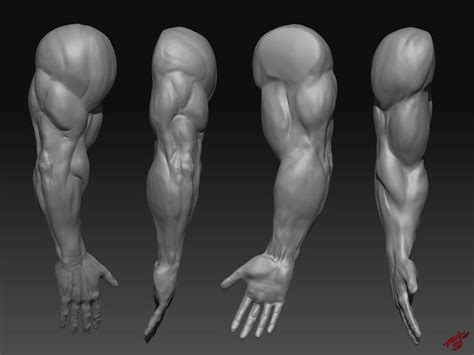The Ultimate Guide to Arms: Strength Training for Superior Performance
Introduction
Arms play a vital role in our daily lives, from performing tasks to participating in physical activities. Strengthening the arms offers numerous benefits, including improved overall strength, enhanced functionality, and aesthetic appeal. This comprehensive guide delves into the anatomy of the arms, its functions, and effective strategies for developing stronger arms. By understanding the mechanics of the arms and implementing proper training techniques, individuals can maximize their arm strength and optimize their physical performance.
Understanding the Anatomy of the Arms
The arms consist of two main sections: the upper arm and the forearm.
Upper Arm
The upper arm houses three primary muscles:

-
Biceps brachii: The biceps muscle is responsible for flexing the elbow joint and supinating (rotating) the forearm.
-
Triceps brachii: The triceps muscle extends the elbow joint and contributes to shoulder extension.
-
Brachialis: The brachialis muscle assists the biceps in flexing the elbow joint.
Forearm
The forearm is composed of various muscles, including:

-
Flexor carpi radialis: This muscle flexes the wrist joint.
-
Flexor carpi ulnaris: The flexor carpi ulnaris muscle flexes and ulnarly (toward the little finger) deviates the wrist.
-
Extensor carpi radialis longus and brevis: These muscles extend the wrist joint.
-
Pronator teres: The pronator teres muscle pronates (rotates) the forearm inward.
-
Supinator: The supinator muscle supinates the forearm.
Functions of the Arms
The arms play a crucial role in a wide range of movements, including:


- Pushing and pulling motions
- Elbow flexion (bending) and extension (straightening)
- Wrist flexion, extension, and deviation
- Pronation and supination of the forearm
Strong arm muscles allow individuals to perform these movements more efficiently and with greater strength.

Benefits of Strengthening Arms
Developing stronger arms offers numerous benefits:
-
Improved overall strength: Strong arms contribute to overall body strength, enhancing performance in various physical activities, such as lifting weights or playing sports.
-
Enhanced functionality: Stronger arms improve the ability to perform everyday tasks, such as carrying groceries or opening jars.
-
Aesthetic appeal: Well-developed arms enhance physical appearance and contribute to a balanced physique.
-
Injury prevention: Strong arm muscles provide stability and support to the joints, reducing the risk of injuries.
Effective Strategies for Strengthening Arms
Proper training techniques are essential for maximizing arm strength. Here are some effective strategies:

Compound Exercises
Compound exercises target multiple muscle groups simultaneously, maximizing efficiency and building overall strength. Effective compound exercises for the arms include:
-
Barbell curls: Engage the biceps, brachii, and forearms.
-
Tricep pushdowns: Target the triceps and assist in elbow extension.
-
Overhead tricep extensions: Focus on the triceps and shoulder muscles.
Isolation Exercises
Isolation exercises isolate specific muscle groups, allowing for focused development. Recommended isolation exercises for the arms include:
-
Hammer curls: Isolate the biceps muscle.
-
Tricep isolation: Target the triceps independently.
-
Wrist curls: Strengthen the forearm muscles.
Progressive Overload
To continually improve arm strength, it is crucial to implement progressive overload, gradually increasing the weight or resistance over time. This challenges the muscles and promotes adaptation.
Rest and Recovery
Adequate rest and recovery are essential for muscle growth and repair. Allow for 24-48 hours of rest between arm workouts.


Frequency and Intensity
Optimal training frequency and intensity vary based on individual fitness levels. Aim for 2-3 arm workouts per week, with sufficient intensity to challenge the muscles without overexertion.
Common Mistakes to Avoid
To optimize arm strength development, it is important to avoid common mistakes that can hinder progress:
-
Overtraining: Exceeding the body's ability to recover can lead to burnout and decreased performance.
-
Ignoring proper form: Poor form can result in injuries and reduced effectiveness.
-
Neglecting recovery: Insufficient rest can impair muscle growth and increase the risk of injuries.
-
Chasing "pump": Focusing solely on achieving a muscle pump can limit long-term strength gains.
-
Training to failure: Training to exhaustion can compromise form and hinder progress.
FAQs
1. How often should I train arms?
For most individuals, 2-3 arm workouts per week are sufficient.
2. What is the best way to warm up before an arm workout?
Begin with light cardio, followed by dynamic stretches for the target muscle groups.
3. How much weight should I use?
Start with a weight that challenges you while maintaining good form. Gradually increase weight over time.
4. How long should I rest between sets?
Rest for 60-90 seconds between sets to allow for muscle recovery.
5. Can I build strong arms without weights?
Bodyweight exercises, such as push-ups and dips, can effectively strengthen the arms.
6. How long does it take to see results?
With consistent training and nutrition, noticeable results can be achieved within 4-8 weeks.
Call to Action
Embracing the strategies outlined in this guide can help individuals develop stronger, more functional arms. By implementing proper training techniques, avoiding common mistakes, and dedicating to a consistent workout routine, you can unlock your arm strength potential and enjoy the numerous benefits that come with it. Invest in your physical health today and embark on a journey towards superior arm strength.
